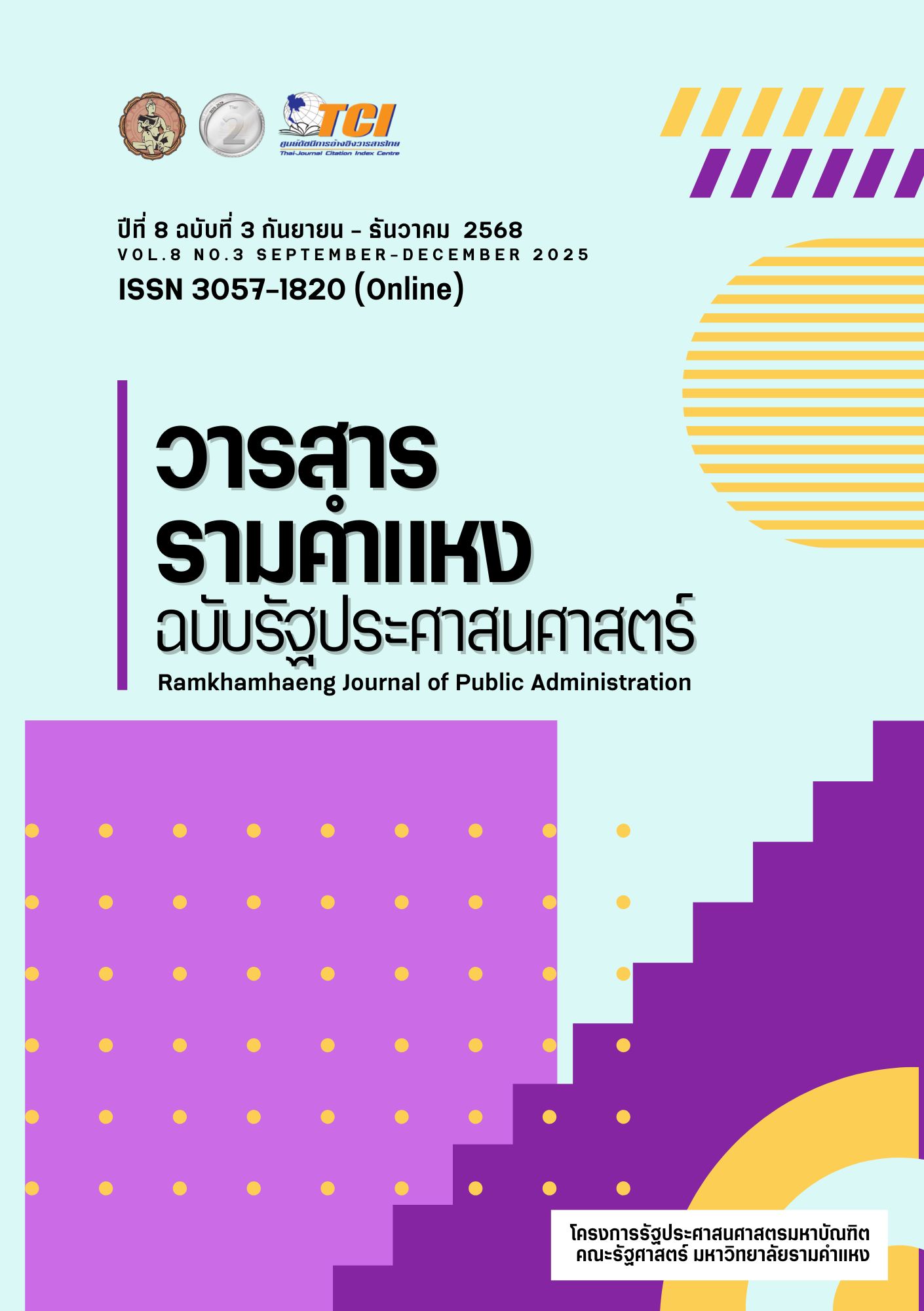The Influence of Supervisory Trust and Organizational Trust on Individual Creativity of Public Sector and Private Sector’s Officers in Bangkok Area
Keywords:
individual creativity, Supervisory Trust, Organizational TrustAbstract
The purposes of this research were to analyzed: (1) the relationships between supervisory trust, organizational trust, and individual creativity, and (2) supervisory trust, organizational trust influencing individual creativity. This research employed a quantitative research was examined its quality through the validity and reliability as the instrument for data collection. The data were collected from a sample of 400 Officers of Public Sector and Private Sector in Bangkok Area. The descriptive analysis included Frequency, Percentage, Mean, and Standard Deviation. The analysis by Inferential Statistics included Pearson’s correlation, and stepwise multiple regression analysis.
Findings are as follows: (1) The researcher found that individual creativity was positively correlated with supervisory trust, and organizational trust, (2) Factoring influencing individual creativity was supervisory trust.
References
กระทรวงแรงงาน. (2566). รายงานผลการวิเคราะห์ข้อมูลอุปสงค์และอุปทานแรงงานกรุงเทพมหานคร ปี 2567. กรุงเทพมหานคร: กองเศรษฐกิจการแรงงาน สำนักปลัดกระทรวงแรงงาน.
กัลยา วานิชย์บัญชา. (2547). หลักสถิติ (พิมพ์ครั้งที่ 7). กรุงเทพมหานคร: โรงพิมพ์แห่งจุฬาลงกรณ์มหาวิทยาลัย.
เฉลิมชัย กิตติศักดิ์นาวิน. (2552). ความไว้วางใจในองค์การของประเทศไทย ศึกษาเปรียบเทียบองค์การภาครัฐ ภาครัฐวิสาหกิจและภาคเอกชน. ดุษฎีนิพนธ์ปรัชญาดุษฎีบัณฑิต สาขาวิชารัฐประศาสนศาสตร์, มหาวิทยาลัยรามคำแหง
เฉลิมชัย กิตติศักดิ์นาวิน,ดร.(2553). “ผู้นำและองค์การแห่งความไว้วางใจ: ปัจจัยสำคัญสู่ความสำเร็จในยุคโลกาภิวัตน์และการเปลี่ยนแปลง”. เสนอในงานประชุมวิชาการรัฐศาสตร์และรัฐประศาสนศาสตร์แห่งชาติครั้งที่ 11 ณ มหาวิทยาลัยมหาสารคาม วันที่ 25 พฤศจิกายน 2553.
เฉลิมชัย กิตติศักดิ์นาวิน. (2555). “ความไว้วางใจในผู้บังคับบัญชาและความไว้วางใจในองค์การที่มีอิทธิพลต่อความคิดสร้างสรรค์ของบุคคล”. บทความวิจัยนำเสนอการประชุมวิชาการระดับชาติ SMART Conference ครั้งที่ 2 มหาวิทยาลัยเกษตรศาสตร์ วิทยาเขตศรีราชา จังหวัดชลบุรี วันที่ 18 พฤษภาคม 2555.
เฉลิมชัย กิตติศักดิ์นาวินและจิรวัฒน์ ปฐมพรวิวัฒน์. (2555). “ความสัมพันธ์ระหว่างความไว้วางใจในผู้บังคับบัญชากับความไว้วางใจในองค์การและความผูกพันต่อองค์การ ศึกษาพนักงานระดับปฏิบัติการของธนาคาร กสิกรไทย จำกัด (มหาชน) เขต 51”. เสนอในงานประชุมวิชาการศิลปากรวิจัยและสร้างสรรค์ ครั้งที่ 5 มหาวิทยาลัยศิลปากร วิทยาเขตพระราชวังสนามจันทร์ จังหวัดนครปฐม วันที่ 25-27 มกราคม 2555.
เฉลิมชัย กิตติศักดิ์นาวินและอลงกต จิตต์ปราณี. (2555). “ปัจจัยที่มีอิทธิพลต่อพฤติกรรมการเป็นสมาชิกที่ดีในองค์การของพนักงานวิสาหกิจขนาดกลางและขนาดย่อม(SMEs) ในเขตจังหวัดนครปฐม”. เสนอในงานประชุมวิชาการศิลปากรวิจัยและสร้างสรรค์ ครั้งที่ 5 วันที่ 25-27 มกราคม 2555.
เฉลิมชัย กิตติศักดิ์นาวิน.(2556). “ความไว้วางใจในผู้บังคับบัญชาและความไว้วางใจในองค์การที่มีอิทธิพลต่อความคิดสร้างสรรค์ของบุคลากรองค์การปกครองส่วนท้องถิ่น”. บทความวิจัยนำเสนอการประชุมวิชาการรัฐศาสตร์และรัฐประศาสนศาสตร์แห่งชาติครั้งที่ 14 ณ มหาวิทยาลัยอุบลราชธานี วันที่ 27-28 พฤศจิกายน 2556.
เฉลิมชัย กิตติศักดิ์นาวิน. (2558).“ความไว้วางใจในผู้บังคับบัญชาและความไว้วางใจในองค์การที่มีอิทธิพลต่อความคิดสร้างสรรค์ของบุคลากรเทศบาลนครนครปฐม”. วารสารมนุษยศาสตร์และสังคมศาสตร์ มหาวิทยาลัยมหาสารคาม. 34(พิเศษ), 95-101.
สำนักงาน ก.พ. (2566). กำลังคนภาครัฐ. กรุงเทพมหานคร: ศูนย์เทคโนโลยีสารสนเทศและการสื่อสาร สำนักงาน ก.พ.
Amabile, T.M.(1999). “How to kill creativity.” In Harvard Business Review on Breakthrough Thinking. Boston, MA: Harvard Business School Press.
Amabile, T.M., Conti, R., Coon, H., Lanzenby, J. and Herron, M. (1996). “User’s Manual for KEYS: Assessing the work environment for creativity”. The Academy of Management Journal, 39(5). 1154-1184.
Andriopoulos, C. and Lowe, A. (2000). “Enhancing organizational creativity: The process of perpetual challenging”. Management Decision, 38 (10), 734-742.
Cumming, A. and Oldham, G.R.(1997).“Enhancing creativity: managing work contexts for the high potential employee”. California Management Review, 40(1), p. 22-38.
Davis, J. H., Schoorman, F. D., Mayer, R. C., & Tan, H. H. (2000). The trusted general manager and business unit performance: Empirical evidence of a competitive advantage. Strategic Management Journal, 21, 563-576.
Dewett, T.(2006). “Exploring the role of risk in employee creativity”. Journal of Creative Behavior. 40(1), p. 27-45.
Healey, J. (2007). Radical Trust: How today’s great leaders convert people to learning. New York: John Wiley & Sons.
Gilbert, J. A., & Tang, T. L. (1998). “An examination of organizational trust antecedents” Public Personnel Management, 27(3), 321-338.
Gillespie, N. A., & Dober, G. (2003). Managing trust during organizational transitions. Paper presented at MBS Alumni, London & New York.
Guilford, J.P.(1980) “Cognitive Styles: What are they?”. Journal of Educational and Psychological Measurement, 40, 715-735.
Kanter, R.M.(1983). The Change Masters: Innovation and Entrepreneurship in the American Corporation. New York: Simom & Schuster.
Korsgaard, M.A., Sapiena, H. J., & Schweiger, D. M. (2002). “Beaten before begun: The role of procedural justice in planning change”. Journal of Management, 28(4), 497-516.
Luhman, N. (1979). Trust and power: Two works by Niklas Luhman. New York: John Wiley & Sons.
Marshall, E. M. (2000). Building trust at the speed of change: The power of the relationship-based corporation. New York: McGraw-Hill.
Mayer, R. C., Davis, J. H., & Schoorman, F. D. (1995). “An integrative model of organization trust”. Academy of Management Review, 20(3), 709-734.
McGregor, J.(2007). “The world’s most innovative companies”. Business Week Online, May 4, p.9.
McKnight, E. M., Cummings, L. L., & Chervany, N. L. (2006). “Initial trust formation in new organization relationships”. In R. M. Kramer (Ed.), Organizational trust: A reader (pp. 111-139). Oxford, United Kingdom: Oxford University Press.
Morgan, D. E., & Zeffane, R. (2003). “Employee Involvement, organizational change and trust in management”. International of Human Resource Management, 14(1), 55-75.
Perry, R. W., & Mankin, L. D. (2007). “Organizational trust, trusts in the chief executive and work satisfaction”. Public Personnel Management, 36(2), 165-179.
Robbins, S. P. (2005). Organization behavior (11th ed.). Englewood Cliffs, NJ: Prentice-Hall.
Sako, M. (1998). “Does Trust Improve Business Performance?”. In C. Lane & R. Bachman (Eds), Trust within and between organizations: Conceptual issues and empirical applications (pp. 88-117). Oxford, United Kingdom: Oxford University Press.
Tesluk, P.E.; Farr, J.L. and Klein, S.R. (1997). “Influences of Organizational culture and climate on individual creativity”. Journal of Creative Behavior. 31(1), p. 27-41.
Tierney, P., Farmer, S.M., and Graen. (1999). “An examination of leadership and employee creativity: The relevance of traits and relationships”. Personnel Psychology, 52, p. 591-620.
Tushman, M. and O’Reilly, C.A. (1997). Winning through Innovation: A Practical Guide to Leading Organizational Change and Renewal. Boston, MA: Havard Business School Press.
Utterback, J.M. (1994). Mastering the Dynamics of Innovation. Boston, MA: Harvard Business School Press.
Von Stamm, B. (2008). Managing innovation, design and creativity (2nd ed.) .UK: John Wiley & Son.
Yamane, T. (1967). Elementary sampling theory. New Jersey: Prentice-Hall.
Downloads
Published
How to Cite
Issue
Section
Categories
License
Copyright (c) 2025 โกสินทร์ เตชะนิยม, เฉลิมชัย กิตติศักดิ์นาวิน, กรพรหม ถิระวัฒน์ , พิมลรัตน์ วงศ์ภูษาประกร, อภิชาติ กิตติศักดิ์นาวิน, ศรวิชา กฤตาธิการ

This work is licensed under a Creative Commons Attribution-NonCommercial-NoDerivatives 4.0 International License.



